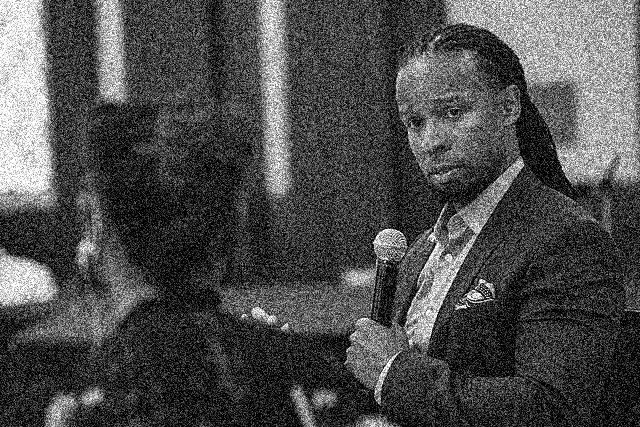The PMC Gets Organized
“Minority unions” could be a fruitful path forward at a nadir of labor’s power, but their lack of focus on traditional workplace demands speaks to a worrying professional-managerial class orientation within these pressure groups.

The “militant white-collar tech worker” is ready to fight. Radicalized by the election of Donald Trump, Silicon Valley workers are eager to shed the traditional apolitical orientation of “creatives” and pursue collective action. The recent announcement of the Alphabet Workers Union, formed in the belly of the company that serves as the most ready referent of the term “Big Tech,” has particularly captured the media imagination.
A recent New York Times article tackles what many consider the primary objection to these unions: that white-collar workers are “too privileged” to organize. The article rightly dismisses this concern: at a for-profit company, every wage worker is in an essentially antagonistic relationship with their employer, no matter how much they make. Nurses and longshoremen regularly make six-figure salaries, but it would be absurd to exclude NNU and ILWU members from the “working class.”
No, the real problem with the Alphabet Workers Union is that it’s not a union. It’s rather a “minority union”—essentially an employee pressure group, formed through the Communication Workers of America (CWA). The traditional organizing process through the National Labor Relations Board (NLRB) requires majority approval, a long, fraught, and fragile process, but one that results in actual bargaining power with management. A minority union, by contrast, can be formed by a very “small activist base”. According to the Wall Street Journal, the “Alphabet Workers Union is composed of fewer than 800 workers among Alphabet’s roughly 250,000 employees and contractors, some of whom are technically employed by completely separate entities, some of which are already unionized.” And their formation as a “union” does not give them any negotiation power, though they do pay dues to CWA.
There is certainly something to be said for minority unionism. In states with very regressive labor laws and political climates, going through the NLRB recognition process is practically impossible. And long before the Wagner Act, minority unionism was in practice just unionism itself: you start with a small group, you grow it, and you force the employer to recognize you through your numbers and militancy. In many ways, the political economic situation of the present bears great similarity to that of the 30s; maybe our organizing tactics should meet that situation.
But there is a danger here that minority unionism today will simply be “union” minoritarianism. Rather than the carefully identified leaders so crucial to building majority support, a mere handful of activists is sufficient to form a minority union. This is not William Z. Foster’s “militant minority,” working within already existing mass organizations to radicalize them, but rather a grouplet of self-identified workplace “radicals” for whom winning majorities is not even an explicit goal, let alone a necessary precondition for the exertion of real power.
The demands described in the Times article certainly seem quite different from the traditional bread-and-butter workplace demands. Tech workers gravitate toward things like banning Trump from their platforms and gender and racial equity within their companies, two demands to which many Silicon Valley executives are probably quite sympathetic—unlike, of course, higher wages, the imposition of “just cause” for discharge, a binding workplace grievance procedure, contractually mandated shop-floor rights, and ultimately more democratic control over the workplace. In the case of demands for informal and extralegal tech censorship over ideologues like Trump, insofar they result in the narrowing of the space for the exercise of civic liberties as a whole, one might even deem this expression of workplace “antagonism” a kind of class collaboration.
The main reason to support the organizing of tech workers, many argue, is that they are strategically situated and thus bear “structural power,” given the importance and size of the digital economy. Just as we should support striking teachers, given their power to disrupt the post-industrial economy, so too should we support this manifestation of professional-managerial class (PMC) revolt.
This, perhaps, is where the traditional PMC categorization loses its utility. Teachers are only PMC in a residual sense: they still need credentials, but haven’t materially benefitted from neoliberal restructuring as tech workers have. When teachers strike, it’s for higher wages and more classroom resources. Flowing as they do from a specific corporate culture, tech worker demands don’t always challenge and thereby extract concessions from management but rather often demonstrate a desire to be management, i.e. to have control over hiring and firing practices, to be more just and inclusive than existing managers, etc.
We needn’t, of course, deny the legitimacy of Google employee organizing, but it’s important to uphold the distinction between actually seeking to represent the needs and desires of their co-workers, i.e. to organize their workplaces, and searching rather for participation in broader liberal currents of “social justice.” There may be some overlap between these two, but their trajectories point in opposing directions.
The former requires that workers take on enormous personal risk in rejecting an “individualist” strategy of self-preservation for a collective strategy forged alongside their co-workers. It also thus requires organizers to rally everyone around not a common identification but rather common interests and possibilities. As Vivek Chibber has written of this classic organizing model,
The basic task of organizers is not to urge everyone else to be like them—since they know that this is a lost cause. It is, rather, to persuade their peers that the organizations and campaigns that they are advocating are desirable and possible. There will be some risk, and the participants will incur some costs, but they are justified because of the promised gains—in security, wages, autonomy, and so on. Solidarity does not evolve into altruism, nor does the willingness to sacrifice amount to an embrace of martyrdom.
In the case of tech minority unions, as Carmen Molinari points out, an orientation around altruistic positions on “ethical and social issues” seems be the starting point. Minority unions could be a first step toward building the trust required for collective action, eventually leading towards the pressure needed to negotiate a contract, but their characteristically PMC orientation seems to point the other way.
One might still cynically argue that we ought to let these white professionals play-act as militant proletarians, so long as they pay their dues to struggling unions. Unions are primed to offer a “working-class experience” to the PMC for the low price of a Netflix subscription, and if the provision of that admittedly somewhat misleading service funds real organizing campaigns elsewhere, so be it.
But there is something dangerous about the PMC union, given the importance of media apparatuses in our attention economy. The Teamsters represent 1.4 million almost exclusively blue-collar workers in trucking, warehousing, and manufacturing. They have 68k Twitter followers. The New Yorker union, which represents 100 some workers, has 11k followers. Given the PMC control over the media, whose labor disputes are going to get the sympathetic press, which demands will appear in headlines? Recently the day-long walkout of fact checkers at the New Yorker and the Teamsters strike at Hunts Point Market both got one article in The New York Times.
The terrifying truth is that these PMC pressure groups could be presented as the union archetype in the near future, while traditional unions become a weird anachronism. Rather than representing a turning of the tide, the PMC union could function as a cruel accelerator of labor’s decline.
Of course, minority unions don’t have to be this way, but their natural composition—aspiring managers + activist-y types—inclines them toward PMC LARPing. If they are really used as organizing vehicles, rather than means of making minoritarian and particularist demands on management, they could be fruitful paths forward at a nadir of labor’s power in America.
But that would require, as with much worth saving in the present, getting the PMC to overcome the confused and oftentimes class collaborationist orientation that issues from their structural position. Maybe the union staff working with these minority unions can take advantage of the PMC’s masochism to do just this, but the difficulty of reorienting the virtue hoarders toward organizing with people they would typically condemn should be apparent.
■
Dom King is a writer from Cleveland (but temporarily a content creator living in Brooklyn).



